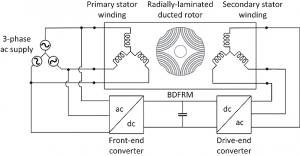Brushless Doubly-Fed Reluctance Machines for Turboelectric Distributed Propulsion Systems
PhD student Shivang with advisor A. Banerjee
Turboelectric propulsion uses no batteries for propulsive energy during any phase of flight (unlike hybrid and all-electric systems) and is considered a critical enabler for low-carbon emissions in the aircraft industry. As batteries with high enough power capacity and the specific power required for commercial aircraft are unlikely to be developed within the next 30 years, turboelectric systems are the only feasible option.
A brushless doubly-fed machine (BDFM) is an attractive option for megawatt-scale turbo-electric propulsion systems due to use of a partially rated power converter, reduced maintenance, and absence of permanent magnets. However, BDFRMs have inherently poor torque density and high torque ripple due to use of a sub-optimal rotor. Figure 1 shows the BDFRM drive architecture. We have propos

Figure 1. Architecture of a BDFRM drive. The primary stator is connected to the ac supply directly, whereas the secondary stator is connected to the same ac supply via a fractionally rated power converter.
ed an analytical model to compute the air-gap flux density and torque characteristics, with the aim of modeling the effect of the flux barriers on the mean and ripple torque. Through analytical and finite element analysis, it has been verified that the flux-barrier ends position highly influences the torque waveform, and thus cannot be arbitrarily designed. Optimizing the rotor geometry along with the stator current excitations can help in achieving a high torque density BDFRM. This research is supported by the Grainger Center for Electric Machinery and Electromechanics.